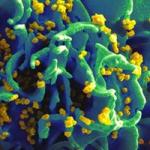
Research Topics
Our research is aimed at understanding host responses to retroviral infections. We use mice infected with Friend murine leukemia virus as a model to study basic immunology. A special interest is in chronic infections, including how chronic infections are established and maintained and developing strategies to prevent and treat them. Using this model, we discovered that viruses can subvert the suppressive nature of regulatory T cells to evade immunological destruction by CD8+ T cells. We also use “humanized” mice that contain human immune systems as a model to study immune responses to HIV infection and to help us determine basic mechanisms of vaccine protection against acute and chronic retroviral infections. We are currently using this model to study possible cures for latent HIV infections and to develop new therapeutics.
Biography
Dr. Hasenkrug received his Ph.D. in cell biology from the Albert Einstein College of Medicine in 1991 and conducted his postdoctoral research in the laboratory of Dr. Bruce Chesebro at the Rocky Mountain Laboratories. In 1998, he established an independent laboratory to study retroviral immunology and mechanisms of vaccine protection. A special focus of his work has been the study of establishment and maintenance of chronic infections and virus escape with a focus on regulatory T cells and T cell exhaustion. Dr. Hasenkrug serves as an affiliated associate professor at Montana State University and the University of Montana. In 2016 he was elected as a Fellow of the American Academy of Microbiology.
Editorial Boards
- PLoS One
- Virology
Selected Publications
- Tal MC, Torrez Dulgeroff LB, Myers L, Cham LB, Mayer-Barber KD, Bohrer AC, Castro E, Yiu YY, Lopez Angel C, Pham E, Carmody AB, Messer RJ, Gars E, Kortmann J, Markovic M, Hasenkrug M, Peterson KE, Winkler CW, Woods TA, Hansen P, Galloway S, Wagh D, Fram BJ, Nguyen T, Corey D, Kalluru RS, Banaei N, Rajadas J, Monack DM, Ahmed A, Sahoo D, Davis MM, Glenn JS, Adomati T, Lang KS, Weissman IL, Hasenkrug KJ. Upregulation of CD47 Is a Host Checkpoint Response to Pathogen Recognition. mBio. 2020;11(3).
- Cham LB, Torrez Dulgeroff LB, Tal MC, Adomati T, Li F, Bhat H, Huang A, Lang PA, Moreno ME, Rivera JM, Galkina SA, Kosikova G, Stoddart CA, McCune JM, Myers LM, Weissman IL, Lang KS, Hasenkrug KJ. Immunotherapeutic Blockade of CD47 Inhibitory Signaling Enhances Innate and Adaptive Immune Responses to Viral Infection. Cell Rep. 2020;31(2):107494.
- Hasenkrug KJ, Feldmann F, Myers L, Santiago ML, Guo K, Barrett BS, Mickens KL, Carmody A, Okumura A, Rao D, Collins MM, Messer RJ, Lovaglio J, Shaia C, Rosenke R, van Doremalen N, Clancy C, Saturday G, Hanley P, Smith B, Meade-White K, Shupert WL, Hawman DW, Feldmann H. Recovery from acute SARS-CoV-2 infection and development of anamnestic immune responses in T cell-depleted rhesus macaques. bioRxiv. 2021.
- Moore TC, Hasenkrug KJ. B-Cell Control of Regulatory T Cells in Friend Virus Infection. J Mol Biol. 2021;433(1):166583.
- Myers LM, Tal MC, Torrez Dulgeroff LB, Carmody AB, Messer RJ, Gulati G, Yiu YY, Staron MM, Angel CL, Sinha R, Markovic M, Pham EA, Fram B, Ahmed A, Newman AM, Glenn JS, Davis MM, Kaech SM, Weissman IL, Hasenkrug KJ. A functional subset of CD8+ T cells during chronic exhaustion is defined by SIRPα expression. Nat Commun. 2019;10(1):794.
Related Scientific Focus Areas


Microbiology and Infectious Diseases
View additional Principal Investigators in Microbiology and Infectious Diseases

This page was last updated on Wednesday, July 6, 2022